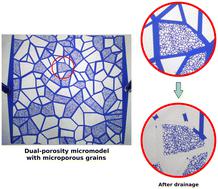Our official English website, www.x-mol.net, welcomes your
feedback! (Note: you will need to create a separate account there.)
Dual-porosity micromodels for studying multiphase fluid flow in carbonate rocks
Lab on a Chip ( IF 6.1 ) Pub Date : 2022-11-08 , DOI: 10.1039/d2lc00445c Fabiano G Wolf 1 , Diogo N Siebert 2 , Marcelo N P Carreño 3 , Alexandre T Lopes 3 , Alexandre M Zabot 2 , Rodrigo Surmas 4
Lab on a Chip ( IF 6.1 ) Pub Date : 2022-11-08 , DOI: 10.1039/d2lc00445c Fabiano G Wolf 1 , Diogo N Siebert 2 , Marcelo N P Carreño 3 , Alexandre T Lopes 3 , Alexandre M Zabot 2 , Rodrigo Surmas 4
Affiliation

|
Carbonate rocks usually present a wide variation in pore size within a sample and may contain macroscopic pores ranging from a few millimeters to microscopic pores smaller than one micrometer. Therefore, studying the fluid flow inside carbonates presents a challenging problem. This study proposes a methodology to create dual-porosity micromodels for studying single and two-phase fluid flow in multiscale, carbonate-like, rocks. For this purpose, a design technique for Rock-on-a-Chip (ROC) devices based on the Voronoi tessellation was extended to take into account bimodal pore size distributions, allowing the creation of a macroporous system made up of larger channels and vugs that can be filled with distinct microporosity types. The porous media thus generated were then employed to fabricate polymer micromodels by applying the soft lithography technique. Experimental and numerical results show that the microporosity can increase or reduce the permeability, depending on whether it is added to the grains and/or to the large channels. Even when the microporous matrix completely filled the large channels, the addition of vugs did not increase the permeability. Regarding two-phase fluid flow, the location of the steady-state fluids after drainage clearly depends on the proportion and spatial distribution of microporosity, as well as its type. For the micromodel with microporous grains, no significant amount of wetting fluid was displaced from the micropores. In contrast, when microporosities fill the large channels, the injected fluid forces the displacement of the wetting liquid from the micropores, although far from effectively. The novel approach presented in this work represents a step forward in the artificial generation of more representative micromodels for studying fluid flow at the pore scale.
中文翻译:

用于研究碳酸盐岩中多相流体流动的双孔微模型
碳酸盐岩样品中的孔隙大小通常变化很大,可能包含从几毫米到小于一微米的微观孔隙的宏观孔隙。因此,研究碳酸盐岩内部的流体流动是一个具有挑战性的问题。本研究提出了一种创建双孔微模型的方法,用于研究多尺度、类碳酸盐岩石中的单相和两相流体流动。为此,扩展了基于 Voronoi 镶嵌的 Rock-on-a-Chip (ROC) 设备的设计技术,以考虑双峰孔径分布,允许创建由更大的通道和孔组成的大孔系统可以填充不同的微孔类型。然后,通过应用软光刻技术,将由此生成的多孔介质用于制造聚合物微模型。实验和数值结果表明,微孔隙率可以增加或降低渗透率,这取决于它是否被添加到颗粒和/或大通道中。即使当微孔基质完全充满大通道时,添加孔洞也不会增加渗透性。对于两相流体流动,排水后稳态流体的位置显然取决于微孔隙率的比例和空间分布及其类型。对于具有微孔颗粒的微模型,没有显着量的润湿液从微孔中流出。相反,当微孔填充大通道时,注入的流体迫使润湿液从微孔中排出,尽管远非有效。这项工作中提出的新方法代表了在人工生成更具代表性的微观模型以研究孔隙尺度的流体流动方面向前迈出了一步。
更新日期:2022-11-08
中文翻译:

用于研究碳酸盐岩中多相流体流动的双孔微模型
碳酸盐岩样品中的孔隙大小通常变化很大,可能包含从几毫米到小于一微米的微观孔隙的宏观孔隙。因此,研究碳酸盐岩内部的流体流动是一个具有挑战性的问题。本研究提出了一种创建双孔微模型的方法,用于研究多尺度、类碳酸盐岩石中的单相和两相流体流动。为此,扩展了基于 Voronoi 镶嵌的 Rock-on-a-Chip (ROC) 设备的设计技术,以考虑双峰孔径分布,允许创建由更大的通道和孔组成的大孔系统可以填充不同的微孔类型。然后,通过应用软光刻技术,将由此生成的多孔介质用于制造聚合物微模型。实验和数值结果表明,微孔隙率可以增加或降低渗透率,这取决于它是否被添加到颗粒和/或大通道中。即使当微孔基质完全充满大通道时,添加孔洞也不会增加渗透性。对于两相流体流动,排水后稳态流体的位置显然取决于微孔隙率的比例和空间分布及其类型。对于具有微孔颗粒的微模型,没有显着量的润湿液从微孔中流出。相反,当微孔填充大通道时,注入的流体迫使润湿液从微孔中排出,尽管远非有效。这项工作中提出的新方法代表了在人工生成更具代表性的微观模型以研究孔隙尺度的流体流动方面向前迈出了一步。











































 京公网安备 11010802027423号
京公网安备 11010802027423号